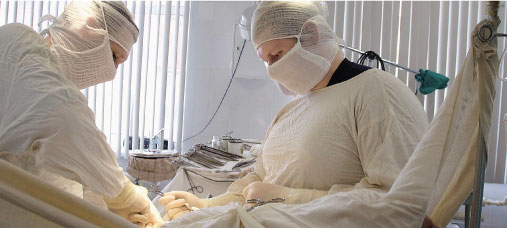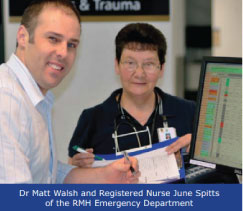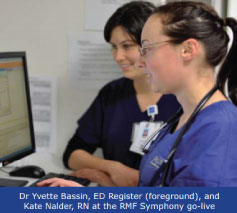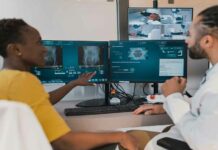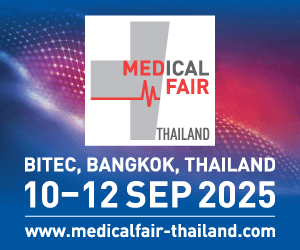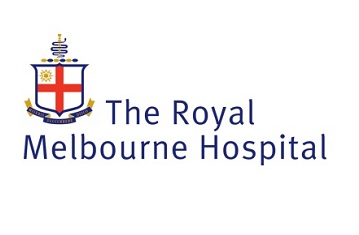A $56.3 million redevelopment began in 2005 on the RMH Emergency Department. The project, completed in October 2009, has significantly expanded ED capacity to 106 beds to cater for an anticipated 65,000 attendances per year by 2015.
Royal Melbourne Hospital has now been live on Symphony for more than one year. The benefits gained and realized since implementing Symphony are positively impacting the department, staff and patients every day…
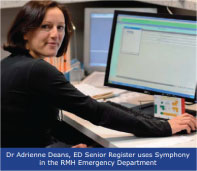 IMPROVING QUALITY AND SAFETY IN MRI REQUESTS
IMPROVING QUALITY AND SAFETY IN MRI REQUESTSAscribe implementation specialists and the RMH project teams have combined their efforts to improve the clinical safety and appropriateness of MRI requests. An MRI Checklist has been incorporated into the electronic MRI request in Symphony.
This has resulted in:
• The ability to prevent staff initiating an MRI request if there is an absolute contraindication e.g. Pacemaker in situ.
• Mandating further clinical details to be recorded if there is a relative contraindication for the request.
• 100% compliance in completing the screening questionnaire and MRI request details.
• Ability to limit the type of MRI requests initiated from the ED.
• Ability to limit MRI ordering to senior medical staff.
Radiology staff no longer receive MRI requests that are initiated inappropriately from the ED, have incomplete checklists or have incomplete or illegible details. The need for radiology staff to follow up problematic requests is now minimised and close to being eliminated.
IMPROVED SAFETY OF BLOOD PRODUCTS ORDERED USINGSYMPHONY
The recent implementation of Symphony in the ED has enabled staff to initiate the ordering of blood products electronically. Using Symphony configuration and orders conditionality, the department has implemented use of electronic signatures for verification and limited blood product ordering to authorized medical staff.
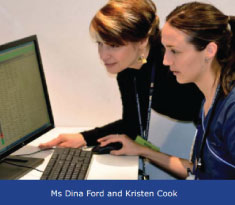
Electronic orders are now fully compliant with National Health and Medical Research Council clinical guidelines for the use of blood components, with all required order information being pre-printed on the order form.
A spot audit for March 2010 revealed 32 requests through Symphony and 6 via paper forms. Of the 32 Symphony initiated requests 100% were compliant with NHMRC guidelines.
Overall, the performance of the ED for blood product ordering has improved significantly (82%) with the implementation of electronic blood product orders using Symphony.
A total of 38 requests for blood products were audited in March, 2010 with 32 being Symphony initiated requests (100% compliant) and 6 on paper forms for a total outcome of 84% compliance overall with NHMRC guidelines.
This represents an 82% improvement on compliance rates for the same period in 2009. Other Melbourne Health requirements indicated above showed significant improvements in quality compliance.
ELIMINATION OF PATHOLOGY SPECIMEN TRANSCRIPTION ERRORS
Staff in pathology reception often struggles with deciphering what tests have been ordered and by whom for a variety of reasons e.g. illegible hand writing and non standard test abbreviations. During the implementation of Symphony at the RMH, the project team looked at end to end process issues. The simplest workflow was automated generation of pathology request forms locally in the ED once tests has been requested on Symphony. The form is then sent to pathology with the collected specimens.
Form design incorporated:
• A bar coded UR number
• All tests listed individually
• Incorporation of the lab code and bar code on the form
• Mandatory question “Is the patient on Warfarin?”
• Automated incorporation of alerts “e.g. multi resistant organism”
• Electronic signature
• Clear identification of who requested the tests
Excellent collaboration with the form design has resulted in the elimination of interpretation and transcription errors. The pathology lab now has 100%certainty what the clinicians are requesting every time. Running the wrong tests or multiple phone calls to clinicians for clarification has been eliminated. Bar coding has delivered faster processing times through specimen reception.

PATHOLOGY ORDERING USING SYMPHONY
Implementation of Symphony in the ED has provided staff with electronic diagnostic orders and pre-populated order forms printed on the demand to send with pathology samples. The benefits achieved are:
• Elimination of the need to find labels for forms
• Electronic verification of pathology requests
• Legibility of requested tests and initiating doctor
• Ability to restrict the ordering of certain tests to authorized staff
• Enormous time savings for staff and patient treatment
FINANCIAL SAVINGS THROUGH USE OF EAUDIT AND CONDITIONALITY IN PATHOLOGY ORDERING
The implementation of Symphony has not only provided electronic orders for pathology and radiology, but also a fast and easy audit tool using eAudit. eAudit has enabled ED staff to study the volumes and types of pathology tests requested in the ED. Clinical practice has been modified, based on the audit results, to facilitated more efficient and cost effective pathology ordering. Using eAudit, ED staff identified the number of Troponin and CK tests ordered in the department. They also looked at the combination of requesting both Troponin and CK together, a largely historical practice.
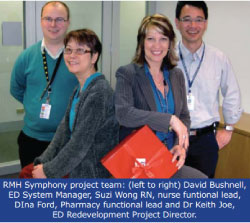
By uncoupling the ordering of Troponin with CK was eliminated. An estimated $2500.00 per week saving is projected in the coming financial year. This simple audit and quality management project is now being extended to study and requesting of lipase and amylase together, and other tests such as D-Dimer that have significant cost or impact on patient investigation pathways.

